Top News
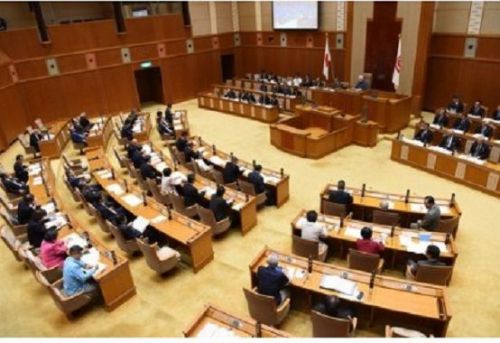
February 22, 2018 Ryukyu Shimpo
On February 21, the Okinawa Prefectural Assembly unanimously adopted a written statement and protest resolution requesting the immediate closure of Futenma Air Station.
These were adopted in response to a Futenma Air Station MV-22 transport Osprey’s engine intake cowling that dropped to the ground on February 8.
The Assembly pointed out that the repeated U.S. military aircraft accidents constitute extremely unusual circumstances.
Furthermore, the Assembly stated that airborne training exercises continue while there are no signs of improvement to the U.S. military’s safety management systems.
It asserted that it absolutely cannot approve of the U.S. military’s contemptuous attitude toward Okinawans, and that the voices calling for the withdrawal of the Marines from Okinawa are becoming louder.
Moreover, the Assembly severely criticized the U.S. and Japanese governments, reminding them that Okinawa is not a colony.
In response to aircraft based at Futenma Air Station repeatedly experiencing trouble and emergency landings, on February 1 the Prefectural Assembly adopted a resolution calling for the immediate closure of Futenma Air Station and the relocation of the U.S. Marine Corps out of Okinawa or even out of Japan.
The resolution from February 1 and the new resolution are alike in that, for the first time since Okinawa was returned to Japanese sovereignty, they include the words: “Okinawa is not a colony.”]
This more recent protest resolution in response to the Osprey fuselage piece dropping to the ground asks for, (1) a thorough inspection into the cause of the accident and a public announcement regarding the results, (2) a halt to flights and training involving aircraft based at Futenma Air Station over private land, (3) the immediate closure of Futenma Air Station, and (4) a drastic revision of the U.S.-Japan Status of Forces Agreement.
The U.S. Marines in Okinawa did not report the fallen aircraft part until the Okinawa Defense Bureau made an inquiry about it.
This protest resolution states that the lack of notification from U.S. military to the Japanese government about the accident calls into question whether there was intent to conceal the incident.
The protest resolution is addressed to Prime Minister Shinzo Abe and the U.S. Ambassador to Japan William Hagerty, among others.
(English translation by T&CT and Erin Jones)
Go to Japanese
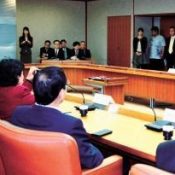
February 21, 2018 Ryukyu Shimpo
Okinawa Governor Takeshi Onaga held a conference to exchange ideas with Japan’s House of Councillors’ Committee on Foreign Affairs and Defense (Shingo Miyake, Chairman), at the Okinawa Prefectural Office February 20, while the committee was visiting Okinawa. Ichiro Tsukada (Liberal Democratic Party – LDP), one of the committees directors, stressed the importance of the relocation of MCAS Futenma to Henoko in Nago City. In response to this, Governor Onaga referenced the declarations of former cabinet ministers to request the committee reconsiders, stating, “What is being said is that [the base] can only be in Okinawa for political reasons, rather than out of military necessity. If that is the case, I must implore you to rethink putting the base in Okinawa.”
Regarding the base relocation issue, Governor Onaga indicated, “If we were to propose that we fill in Lake Towada in Akita Prefecture, or Matsushima Bay in Miyagi Prefecture, or Lake Biwa in Shiga Prefecture, I doubt that the Diet representatives from those regions would be able to stomach it for the safety of Japan.” He continued, “Henoko is only 20-30 kilometers from Futenma. To say that this is a considerable move, or that is it OK if the aircraft crash into the sea, breaks my heart.”
The governor also mentioned the reality of American Military aircraft making crash landings and dropping parts from the air, noting, “The core of the current Japanese government says that they have whole-hearted devotion and will reduce the burden on Okinawa, these are just words. The reality of the bases is that we have had as many as 30 incidents over the past year, and the burden feels quite harsh.” He touched on the incident where a window fell onto the grounds of Futenma Dai-ni Elementary School in Ginowan imploring the committee members to consider, “If we are unable to definitively end incidents like these, is feels as if Japan’s sovereignty is meaningless.”
Right before Governor Onaga’s statement, Tsukada stressed the importance of the relocation, saying, “If this is completed, the flight paths will be over the ocean, and will increase safety as well as greatly reduce the noise pollution.”
(English translation by T&CT and Sam Grieb)
Go to Japanese
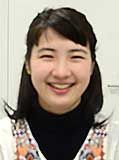
February 21, 2018 Ryukyu Shimpo
On February 3, a preliminary round of the “International Public Speaking Competition 2018” sponsored by the English-Speaking Union was held in Tokyo. Marino Uezu from Urasoe City (a freshman at Ochanomizu University) won this round.
As a representative of Japan, she will participate in the world event held in London starting on May 14.
Uezu said, “I will practice and practice so I do not regret [being unprepared].
I want to surprise the audience with how well Japanese people can speak English.”
The participants compete by making a 5-minute speech about a topic assigned to them and answering questions from judges, then giving a 3-minute speech on a theme picked in a raffle.
They are judged on their expressive abilities in English.
Entrants must be 20 years old or under to qualify.
About 30 people participated in the preliminary round in Japan, and representatives from more than 50 countries will participate in the world competition.
A representative from Japan has never been named within the top seven finalists.
She has asked a previous representative from Japan and native English speakers to be an audience her practice speech.
She said, “I will prepare thoroughly so as to avoid any regrets.”
Uezu has participated in numerous English speech contests, such as when she was selected to represent Okinawa at the Takamado Cup of All Japan Junior High School English Speech Contest during her time at Okinawa Catholic Junior High School.
Last April, she became a college student in Tokyo.
She is affiliated with the Japan National Student Association Fund and volunteers teaching English to junior high school students.
(English translation by T&CT and Megumi Chibana)
Go to Japanese
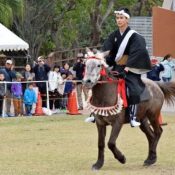
February 22, 2018 Ryukyu Shimpo
N’maharashi, the Ryukyuan traditional horse racing in which horses compete in beauty, speed, and running-rhythm categories, was held at the Okinawa Zoo & Museum in Goya, Okinawa city on February 11.
Twenty-six horses from all over Okinawa including neighboring islands performed at the event, entertaining the audiences with its rare running techniques and beautiful decorations.
It featured the first participation from outside of Okinawa since the event was brought back in 2013.
After the competition, the judges awarded Nanami from the Okinawa Zoo & Museum the championship.
N’maharashi, which began the Ryukyu Kingdom era and continued to 1943, is known for its racing in which horses compete with uniquely-paced running techniques.
It is different from common horse racing in which horses and riders compete for speed.
Instead, the competition is decided based on the form and decorations of the horses while running.
There was a five year-old female horse that was born in Ibaraki and raised in Miyagi that for the first time joined the competition from outside Okinawa.
The horse, named Sakura, is a Hokkaido-bred horse known as “Dosanko,” one of the native horses of Japan. Sakura was born with an attractive running technique that caught people’s attention.
Sakura competed against Isu from Kume Island in the first match.
She performed perfect pace and beautiful running posture, yet the judges decided the horse fell just short of winning the race.
The judges commented on the match between Sakura and Isu, saying, “The game was technically a final match.”
Sakura’s rider, Atsuro Yoshida, 17, came from Chiba Prefecture to attend this competition and trained for the match.
He has known Sakura since they were little, saying that “The horse has very calm personality and she never bites.
” He reflected on the match saying, “We performed a perfect pace during the match.”
(English translation by T&CT and Sayaka Sakuma)
Go to Japanese
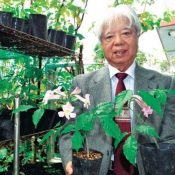
February 23, 2018 Ryukyu Shimpo
In hopes of sending them as a token of his appreciation to those who have supported the cultural exchange, Okinawa Brazil Network Amigo Association President Akihiro Yonashiro, age 74, has been growing more than 200 pots of Ipe, or purple trumpet trees, at his home in Motobu, Haebaru.
The association fosters exchange between Okinawa and Brazil.
Yonashiro says, “We’ve received a lot of donations up to now. I’d be happy if this could be my symbol of appreciation.”
Yonashiro’s also considering asking for help with the cultivation if there are people who are interested in supporting the cultural exchange with Brazil.
Last April, Yonashiro discovered pretty purple Ipe flowers at the family home of the late Okinawa Brazil Association President Kiyonori Miyagi.
He was surprised.
He had said, “You see a lot of yellow, but I have never seen these many purple Ipe.”
After receiving a copious amount of seeds from Miyagi’s family, Yonashiro planted them in May.
The Ipe at Yonashiro’s home are now between 20 to 30 cm and continue to grow.
Over the course of 50 years, Yonashiro utilized his position as a travel agent to interact with Okinawan-Brazilians and also served as the executive director for the Okinawa Brazil Association.
This year will make 110 years since the first Okinawans immigrated to Brazil in 1908.
Yonashiro pointed out the changes in Brazil’s society.
He said, “The third and fourth generations are receiving local education and Brazil continues with the nuclearization of the family.”
He also has high hopes. He said, “We need exchange between Okinawa and Brazil more than ever. I hope that people can further their exchange between Brazil and Okinawa through the purple Ipes.”
Besides sending them as a gift to the donators, the yields from selling the purple Ipe will in turn be used for donations.
For more information, please contact the Okinawa Brazil Network Amigo Association at 098 (867) 3304.
(English translation by T&CT and Chelsea Ashimine)
Go to Japanese
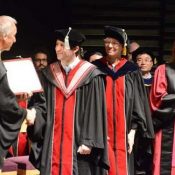
February 25, 2018 Ryukyu Shimpo
Onna – The Okinawa Institute of Science and Technology Graduate University (OIST) in the village of Onna, Okinawa held its first graduation ceremony on February 24.
The post-graduate institute was established in 2011, with the first students beginning their course of study in 2012.
Fourteen scholars from 10 different countries and regions of Japan were awarded PhDs.
Approximately 300 people including parents and those involved in the establishment of the program were in attendance to celebrate the scholars’ completion of studies and departure for new opportunities.
Additionally, an honorary degree was awarded to Koji Omi, 85, who first proposed the creation of OIST while serving as the Minister of State for Okinawa and Northern Territories Affairs.
OIST president Peter Gruss addressed the graduates, quoting Ralph Waldo Emerson, “All life is an experiment. The more experiments you make the better,” before telling the students, “I wish you the best of luck on your next great experiment.”
For the commencement address, Nobel laureate Dr. Steven Chu, who was also one of the visionaries responsible for the creation of OIST, encouraged the students, saying, “Treat the earth well. It was not given to you by your parents. It was loaned to you by your children.”
Dr. Caroline Starzynski, 30, spoke on behalf of the graduate students, saying with a smile, “I wish all of the remaining PhD students lots of persistence, and also luck.”
The graduates will go on to be researchers at Harvard or Tokyo University, or to work as editors at research publications like Springer Nature.
(English translation T&CT and Sam Grieb)
Go to Japan
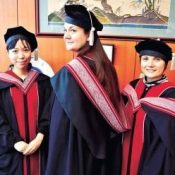
February 12, 2018 Ryukyu Shimpo
On February 24, the Okinawa Institute of Science and Technology Graduate University (OIST) will hold its first graduation ceremony since it opened in 2014. OIST has recently collaborated with the Yuntanza-hanaui Industry Cooperative (which specializes in traditional textiles) to make the hood for the academic dress to be worn by graduates.
Misae Gakiya, who wove the hood piece, said, “I was unfamiliar with academic regalia, so it was difficult to imagine the product.” Looking at students wearing the academic dress, she gladly said, “It is a wonderful garment, and I am very impressed.”
The hood plays a role similar to a certificate of completion.
The OIST President puts it on the graduates. OIST students designed the hoods, and Gakiya of the Cooperative wove them.
Cooperative Director Setsuko Ikehara encouraged students by saying, “Yuntanza-hanaui [textiles] were introduced from overseas 600 years ago.
With this hood, I hope students make the world their stage.”
On February 9, Irina Reshodko (Kazakhstan), Sandrine Burriel (France) and Sakurako Watanabe (Tokyo) visited Yomitan Village Office and reported to Mayor Denjitsu Ishimine.
OIST Graduate University Academic Services Section Manager Harry Wilson, who is in charge of the ceremony, said, “OIST has students from 40 countries.
We wanted to incorporate the tradition of Okinawa.” A student, Reshodko, said that the students also want to keep ties with Okinawa even after graduation.
The hood is woven with red thread of OIST color featuring Jinbana and Kajimayaa-bana patterns, as well as the scientific symbol for a sine wave.
(English translation by T&CT and Megumi Chibana)
Go to Japanese
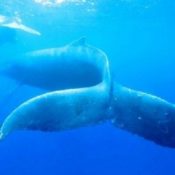
February 15, 2018 Ryukyu Shimpo
As whale watching season reaches its peak, a family of humback whales was found swimming in the harbor near Tokashiki island for about four hours from 10:00 a.m. on February 14.
The family of whales was seen around Gusukujima and the Tokashiki harbor seawall starting February 13.
The whales remained around the same area.
A photographer living in Tokashiki village, Kazunori Nagatani, chartered a boat to take photographs of the whales.
He commented with satisfaction, “I have been taking photos of whales around Kerama over ten yeras, but this is the first time shooting a family of whales in the harbor.”
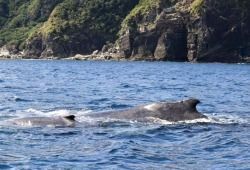
A family of humpback whales swimming in the Tokashiki harbor, taken by Hideaki Yoneda.
According to a villager, it is rare for whales to swim in the harbor.
Passengers on the Tokashiki Ferry and the Tokashiki Marine Liner that connects Naha and Tokashiki may also encounter whales on its path.
(English translation by T&CT and Sayaka Sakuma)
Go to Japanese
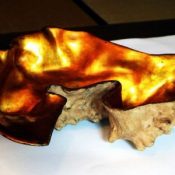
February 9, 2018 Ryukyu Shimpo
Recently it came to light that the Yomei Bunko Foundation of Kyoto has been preserving some artifacts relating to the Ryukyu Kingdom for about 300 years.
Among these items are a particular sake cup (called the Kōrinkaihai) that Confucian scholar Tei Junsoku of Kumemura (who served as magistrate of Nago) presented to the Edo period court noble Konoe Iehiro, and Chinese poetry associated with the Kōrinkaihai.
Also found to have been preserved were records (Butsugairō-ki) that Tei Junsoku and the statesman Sai On compiled concerning an estate of the Konoe clan, Butsugairō.
On February 9 the Okinawa Prefectural Board of Education announced the existence of these artifacts.
The Kōrinkaihai measures 26 centimeters by 21.5 centimeters, and its interior is adorned with gold paint.
Two volumes of records relating to the Kōrinkaihai and two volumes of the Butsugairō-ki were preserved together.
Midori Hokama, who is in charge of the section handling historical records in the Okinawa Prefectural Board of Education’s Cultural Assets Division, explained the significance of finding these artifacts now.
She said that with the artifacts, “We can get a glimpse of the close cultural exchanges between leading persons of culture of the time, including Konoe Iehiro, Tei Junsoku, and Sai On.”
Translator’s note: Names of the Edo period officials were left in the traditional arrangement, with the surname first and given name last.
(English translation by T&CT and Erin Jones)
Go to Japanese
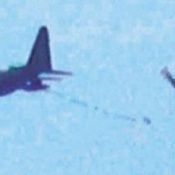
February 16, 2018 Ryukyu Shimpo
It was confirmed around 5:45 p.m. on February 14 that a U.S. Marine Corps MV-22 transport Osprey was engaging in aerial refueling near the hamlet of Ada, Kunigami Village.
The cause of the crash in Abu, Nago City in December 2016 was determined to be an Osprey aerial refueling exercise.
Experts have pointed out the high difficulty level and risk of the operation.
On February 8 part of an Osprey’s fuselage fell to the earth in Uruma, in the midst of Okinawans’ calls for a halt to Osprey flights.
Okinawans have been expressing criticism and uneasiness in response to aerial refueling exercises taking place near private property.
The location where the aerial refueling took place on February 14 was confirmed as being in the direction of the ocean from the police box in Ada.
It is not clear whether the refueling spot was over land or over the ocean.
Regardless, neither the airspace over the hamlet of Ada nor over the ocean has been established as U.S. military training airspace.
Akino Miyagi, a butterfly researcher, witnessed and captured photographs of the refueling exercise.
Miyagi said, “I was unable to clearly tell whether the Osprey was connected to by the fuel hose, or whether it was being extended for connection.
There was a cord-like thing extended between the body of the lead craft [the aerial tanker] and the Osprey flying behind.”
Inquiries have been made to the U.S. Forces Japan in Okinawa in regard to the exercise, but as of 11:30 p.m. on February 15 no reply has been made.
The aerial refueling exercise that resulted in the December 2016 crash took place in airspace over the ocean near Yoronjima, which is not designated training airspace.
In this incident, the fuel hose contacted the Osprey’s propeller.
A similar incident occurred in California in 2015.
(English translation by T&CT and Erin Jones)
Go to Japanese
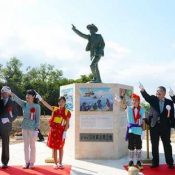
February 20, 2018 Ryukyu Shimpo
Itoman – A statue commemorating the landing of John Manjiro on Odo Beach in Itoman, Okinawa, aptly named the, “John Manjiro Landing Memorial,” was unveiled at a ceremony hosted by Itoman City February 18. The day marked the anniversary of his return to Okinawa, and around 220 people gathered to celebrate the completion of the statue.
Tatsuo Wada, 70, born in Kochi Prefecture but currently living in Itoman said that the construction of the monument came about from the urgings of volunteers in the community, adding, “I want the later generations to learn many things from the voyage of John Manjiro as well as the way he lived his life.”
In 2012 a committee was formed and engaged in activities such as petitioning the city in order to get the statue built.
The statue has a panel embedded into the pedestal that explains the path of Manjiro’s journey, and above is a bronze statue of Manjiro pointing towards his hometown of Tosashimizu, in Kochi.
Also in attendance at the ceremony was Kei Nakahama, a direct descendant of Manjiro, who addressed the crowd, saying, “The completion of this memorial is very moving. I think he would be happy as well.”
John Manjiro was born in what is now called Tosashimizu, Kochi.
In 1841, when he was 14, his fishing boat was wrecked, after which he was rescued by an American whaling vessel and taken to Hawaii.
He studied things like English and navigation in America, and is said to be Japan’s first exchange student.
After earning some money in the Gold Rush, Manjiro was able to pay for his travel back to Japan.
On the journey home, he landed on what is now known as Odo Beach in Itoman (also known as John Man Beach). After an 11-year absence he returned to Tosa, after which he worked as a translator, surveyor, and as an English professor at the Kaisei Academy, the predecessor to Tokyo University.
(English translation by T&CT and Sam Grieb)
Go to Japanese












 Webcam(Kokusai Street)
Webcam(Kokusai Street)


